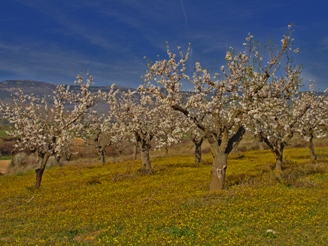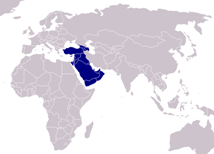Habitat
Prunus dulcis can be found in temperate and desert
climates. This plant flourishes in mild winters, and long hot summers
with low humidity. The Prunus dulcis plant has a
hard time growing in the shade and grows better in direct, hot
sunlight. Prunus dulcis will not
survive in a rainy, moist climate or a climate that is cold
enough for frost. To maintain its fruiting bodies the
plant needs dry and warm. The almond tree prefers deep,
loamy (sand, silt, and
clay),
well-drained (moist not soggy) soils, but if need be it can
tolerate to grow in poor soils.
and grows better in direct, hot
sunlight. Prunus dulcis will not
survive in a rainy, moist climate or a climate that is cold
enough for frost. To maintain its fruiting bodies the
plant needs dry and warm. The almond tree prefers deep,
loamy (sand, silt, and
clay),
well-drained (moist not soggy) soils, but if need be it can
tolerate to grow in poor soils.
Other organisms that grow in these habitats with Prunus dulcis include many mammals, birds, and insects. The ecological niche of almonds also include various deciduous and evergreen trees, and shrubs. Prunus dulcis fits into its ecological niche by being able to grow in low-moisture areas, and in direct sunlight.
Prunus dulcis is spread throughout the northern
temperate regions of the world. The organism originated
from western Asia and continued to spread along the shores of
the Mediterranean in Africa and Southern Europe. The
almond was then brought to California by the Spanish Padres
 and
is now one of the highest planted tree crop in the state.
California is the most common place to find Prunus dulcis
in North America,
but it can also sometimes be found in Vermont.
and
is now one of the highest planted tree crop in the state.
California is the most common place to find Prunus dulcis
in North America,
but it can also sometimes be found in Vermont.
Learn more about the history of the almond..
